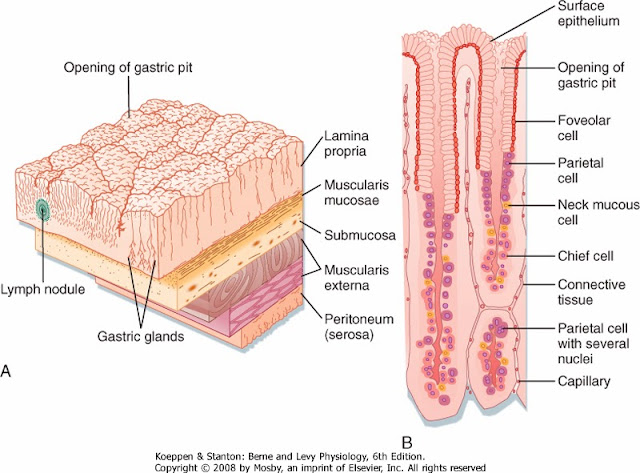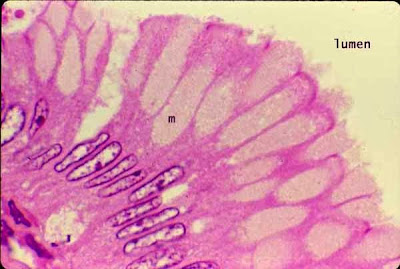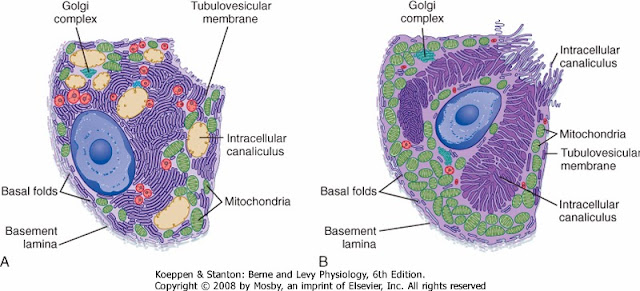
資料來源:users
一.表面黏液細胞(surface mucous cell)
胃黏膜表面含單層柱狀上皮,可分泌含重碳酸根離子(high bicarbonate)的鹼性黏液(alkaline mucin)來中和胃酸,電子顯微鏡下呈小球狀,滿布細胞頂端,3~5 天會更新

資料來源:南伊利諾伊大學醫學院
二.黏液頸細胞(mucous neck cell)
本來是柱狀,但被周圍細胞擠壓成不規則狀,可分泌鹼性黏液(alkaline mucin),與表面黏液細胞相比,黏液頸細胞較短小,且其頂端黏液素原(mucinogen)較少,實驗證明黏液頸細胞可轉變為表面黏液細胞。分布於neck。
資料來源:project2group20
三.未分化細胞(undifferentiated cell)
可增殖分化變為胃腺其他細胞,大多變成表面黏液細胞。分布於neck。
四.壁細胞(parietal cell):大小20~35μm,壽命150~200 天,又名泌酸細胞(oxyntic cell),可分泌HCl 和內因子(intrinsic factor),HCl 使胃蛋白酶原(pepsinogen)轉變為胃蛋白酶(pepsin,使可分解蛋白質),強酸可殺菌,但幽門螺旋桿菌可抗強酸,內因子幫助小腸吸收Vit. B12,供製造RBC,胃潰瘍會使內因子減少,容易貧血。壁細胞內有細胞內小管(intracellular,有微絨毛)、管狀小泡系統(tubulovesicular system)和粒線體,因此胞質呈嗜酸性。壁細胞可能來自以前共生的細菌(neurospora crassa) , 因質子幫浦(H+/K+-ATPase)相似。分布於neck 和body。
壁細胞膜上有胃泌素(gastrin)、組織胺(histamine)和第三型乙醯膽鹼(acetylcholine M3)的受體來影響HCl和內因子的分泌。

資料來源:withfriendship
1.壁細胞要分泌胃酸時,細胞膜會延伸形成長的細胞內小管(intracellular,IC,有微絨毛)壁細胞不分泌胃酸時,細胞膜會縮回形成短的管狀小泡系統(tubulovesicular system,TV)

A, A resting parietal cell showing the tubulovesicular apparatus in the cytoplasm and the intracellular canaliculus. B, An activated parietal cell that is secreting acid. The tubulovesicles have fused with the membranes of the intracellular canaliculus, which is now open to the lumen of the gland and lined with abundant long microvilli.
資料來源:users
五.主細胞(chief cell)
底部含rER(噬鹼性),頂端含分泌性顆粒(嗜酸性),可分泌amylase(分解醣類)、lipase(分解脂質)、pepsin(分解蛋白質)和rennin(分解牛奶中的蛋白質)等蛋白質酵素,胃蛋白酶原(pepsinogen)在強酸(胃酸,PH=2)下才可轉變為胃蛋白酶(pepsin)。分布於body 和base。

資料來源:維基百科
六.腸內分泌細胞(enteroendocrine cell):又名腸嗜鉻細胞(enterochromaffin cell)或腸嗜銀細胞(argentaffin cell),在胃、小腸、大腸均有,但以近端十二指腸和闌尾含量較多,細胞小,靠近腺體底部,會伸出細長突起至管腔,細胞質遍布膜形成的分泌小顆粒(membrane bound granule)。可分泌somatostatin、serotonin、gastrin enteroglucagon、endorphin 等超過20 種肽類或多肽類賀爾蒙

資料來源:利茲大學
▼消化道(Digestive tract)
顯示/隱藏(show/hide)

0 意見:
張貼留言